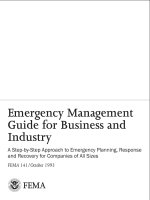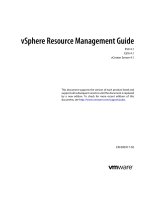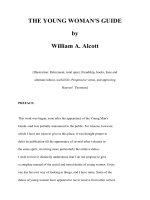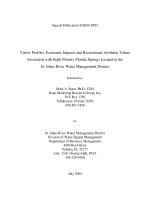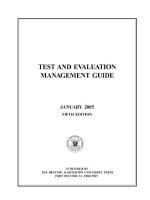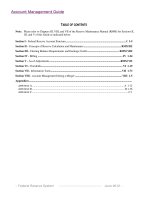Account Management Guide pot
Bạn đang xem bản rút gọn của tài liệu. Xem và tải ngay bản đầy đủ của tài liệu tại đây (5.09 MB, 179 trang )
Account Management Guide
Federal Reserve System June 2012
TABLE OF CONTENTS
Note: Please refer to Chapters III, VIII, and VII of the Reserve Maintenance Manual (RMM) for Sections II,
III, and V of this Guide as indicated below.
Section I - Federal Reserve Account Structure I 1-5
Section II - Concepts of Reserve Calculation and Maintenance RMM III
Section III - Clearing Balance Requirements and Earnings Credits RMM VIII
Section IV - Billing IV 1-24
Section V - As-of Adjustments RMM VII
Section VI - Overdrafts VI 1-19
Section VII - Information Tools VII 1-73
Section VIII - Account Management During a Merger VIII 1-5
Appendices
A
PPENDIX A A 1-12
A
PPENDIX B B 1-36
A
PPENDIX C C 1
Account Management Guide
Federal Reserve
Account Structure
Federal Reserve System June 2012
I - 1
SECTION I
FEDERAL RESERVE ACCOUNT STRUCTURE 2
TERMINOLOGY 3
OPENING AND CLOSING ACCOUNT RELATIONSHIPS 3
USE OF SECONDARY RTNS 4
E
STABLISHING A CORRESPONDENT-RESPONDENT RELATIONSHIP 4
PASS-THROUGH RELATIONSHIPS 5
Account Management Guide
Federal Reserve
Account Structure
Federal Reserve System June 2012
I - 2
FEDERAL RESERVE ACCOUNT STRUCTURE
1
The Federal Reserve Banks generally maintain no more than one debtor-creditor relationship with
a Financial Institution. Under this single-account structure, an Account Holder may only maintain
a single Master Account with a Federal Reserve Bank unless a specific exception applies as
described in Operating Circular 1 (OC 1).
A Financial Institution may apply to open a Master Account and/or obtain Federal Reserve
Services with the Federal Reserve Bank in the Federal Reserve District in which the Financial
Institution is located, which is also known as its Administrative Reserve Bank (ARB). The
Master Account is identified by the Financial Institution’s Primary Routing Transit Number
(“Primary RTN”).
2
Debit and Credit Transaction Activity of the Financial Institution or of the
Financial Institution’s Respondents is ultimately settled in the Financial Institution’s Master
Account.
An Account Holder may also use Secondary Routing Transit Numbers (“Secondary RTNs”) to
segregate Debit and Credit Transaction Activity settling in the Master Account. There are two
types of Secondary RTNs – Subaccount RTNs and Other Secondary RTNs.
3
Both can be used to
identify segregated Debit and Credit Transaction Activity that will settle in the Master Account.
Subaccount RTNs can only be assigned
to Account Holders and are used to identify information
that is reported directly to and settled in the Master Account. Additionally, Subaccount RTNs
can be used to initiate and receive Fedwire
Funds transactions.
4
Additionally, an Account Holder may agree to act as a Correspondent and allow its Master
Account to be used to settle certain transactions and service fees for a Respondent.
5
1
Defined terms that are used in Operating Circular 1 “Account Relationships” (OC 1) shall have the same meaning
when used in this guide. If there is a conflict between the Account Management Guide and Reserve Bank operating
circulars and/or other Reserve Bank policy, the terms of the Reserve Bank operating circular will control. A copy of
OC 1 can be found at:
2
A Routing Transit Number (“RTN”) is an identifying number assigned to a Financial Institution by the Registrar of
Routing Numbers operating under the auspices of the American Bankers Association. An RTN is used in Federal
Reserve applications to identify the Debit and Credit Transaction Activity of a Financial Institution resulting from the
Financial Institution’s use of Federal Reserve Services, Correspondent/Respondent relationships, and the account
structure of a Financial Institution (e.g. Master Account, Subaccount, and Other Secondary RTNs). If an RTN is not
issued by the Registrar of Routing Numbers, the ARB may issue a Customer Identification Number (CIN).
3
The term “Other Secondary RTN,” which is not defined in OC 1, is a Secondary RTN and is defined as a number that
identifies certain Debit and Credit Transaction Activity of a Financial Institution that is reported directly to the
Financial Institution’s Master Account or reported to the Master Account through a Subaccount RTN or through
another Other Secondary RTN assigned to the Account Holder.
4
Fedwire
is a registered service mark of the Federal Reserve Banks.
5
Please refer to the Account Structure, Transaction Settlement, and Reporting Guide (Account Structure Guide) for
additional information for the Federal Reserve Account Structure and transaction settlement rules. The Account
Structure Guide is available at www.frbservices.org
under Rules and Regulations, Operating Circulars.
Account Management Guide
Federal Reserve
Account Structure
Federal Reserve System June 2012
I - 3
All aspects of the Federal Reserve account management functions will be administered by the
ARB through an Account Holder’s Master Account, including balance administration, overnight
overdraft monitoring, daylight overdraft monitoring, and discount window access.
Terminology
Definitions of the following basic terminology associated with the account structure of the
Federal Reserve Banks (Master Account, Secondary RTNs, Correspondent, and Respondent) are
found in OC 1. Familiarization with these terms will assist you in opening and maintaining your
account relationship with the Federal Reserve Banks.
Opening and Closing Account Relationships
Except for a U.S. branch or agency of a foreign bank, in order to establish a Master Account with
its ARB, the Board of Directors of a Financial Institution must pass resolutions (in a form
prescribed by the Reserve Banks) that authorize certain individuals to conduct business on behalf
of the Financial Institution (“Authorized Individuals”).
6
The Financial Institution must provide its
ARB with a certified copy of the resolutions as well as an Official Authorization List (OAL)
which identifies Authorized Individuals. An Authorized Individual must then execute a Master
Account Agreement (Appendix 1 of OC 1) or, if permitted by the ARB, such other agreement that
binds the Financial Institution to OC 1.
By opening or maintaining a Master Account, a Financial Institution agrees to be bound by all the
provisions, as amended from time to time, of OC 1 and of all other Federal Reserve Bank
operating circulars that cover services that it obtains from any Reserve Bank. Each Master
Account is subject to approval of the ARB.
A U.S. branch or agency of a foreign bank must execute the Foreign Banking Institution Account
Agreement and provide resolutions as well as U.S. and foreign opinions of counsel that are
acceptable to the ARB. The Foreign Banking Institution Account Agreement and the additional
required documentation are available upon request from the foreign Financial Institution’s ARB.
7
To open a Master Account at a Reserve Bank, your Financial Institution must also obtain a valid
nine-digit RTN issued by the ABA Registrar of Routing Numbers.
To close a Master Account, you must notify the Reserve Bank in writing at least five business
days prior to the closing date you request.
8
6
Applicable forms are available at www.frbservices.org/forms/account_services.html in the “Account Services –
Forms” section.
7
See www.frbservices.org/forms/account_services.html in the “Account Services – Board Resolution and Official
Authorization List” for the Foreign Bank Board Resolution and OAL.
8
See OC 1 Section 2.10 for the requirements necessary to close a Master Account Agreement, Pass-Through
Agreement, Settlement Authorization Form or Other Agreement.
Account Management Guide
Federal Reserve
Account Structure
Federal Reserve System June 2012
I - 4
Use of Secondary RTNs
An Account Holder may use Secondary RTNs to segregate transaction activity to accommodate
reporting and operational needs. As previously noted, there are two types of Secondary RTNs –
Subaccount RTNs and Other Secondary RTNs. Both can be used to identify segregated Debit
and Credit Transaction Activity that will settle in the Master Account. Subaccount RTNs can
only be assigned
to Account Holders and are used to identify information that is reported directly
to and settled in the Master Account. Additionally, Subaccount RTNs can be used to initiate and
receive Fedwire
Funds transactions.
To use a Subaccount RTN, the Subaccount Designation Form (Attachment A of the Account
Structure and Transaction Settlement Guide) must be completed.
9
The Debit and Credit
Transaction Activity processed for Subaccount RTNs cannot be reported through another
Subaccount RTN and must be reported directly to and settled in the Financial Institution’s Master
Account.
Other Secondary RTNs can be used to identify information that can be reported to a Subaccount
RTN, an Other Secondary RTN (not to exceed three tiers), or directly to the Master Account.
Other Secondary RTNs, however, cannot be used to initiate and receive Fedwire
transactions.
To establish reporting instructions for Other Secondary RTNs, the Transaction and Service Fee
Informational Reporting Instructions for Other Secondary Routing Transit Numbers (RTNs)
Form (Attachment B of the Account Structure and Transaction Settlement Guide) must be
completed by the Account Holder. The Debit and Credit Transaction Activity processed for these
Secondary RTNs can be reported through a Subaccount RTN or an Other Secondary RTN of the
Financial Institution for information purposes, but must settle in the Financial Institution’s Master
Account (for Account Holders). For Financial Institutions that do not have a Master Account, the
Respondent may use an Other Secondary RTN but must use its Primary RTN to settle Debit and
Credit Transaction Activity directly to the Correspondent’s Master Account RTN (not to exceed
three tiers).
Examples and useful diagrams of different uses of Secondary RTNs are included in
the Account Structure Guide.
Establishing a Correspondent-Respondent Relationship
An Account Holder may agree to act as a Correspondent and allow its Master Account to be used
to settle certain transactions and service fees for a Respondent. To establish a Correspondent-
Respondent relationship, the Correspondent and the Respondent must both execute a Transaction
9
If Subaccount RTNs and/or Other Secondary RTNs are being used as a result of a merger, the Merger Matrix form,
when approved by a Federal Reserve Bank, can be used instead of the Subaccount Designation Form. The Merger
Matrix is a form that is intended to assist an institution in planning for accounting changes with the Federal Reserve
Banks that will result from a merger with another institution or as a result of a purchase and assumption of certain
assets or liabilities of another Financial Institution (collectively referred to as a merger). The document covers services
that need to be addressed prior to an inter- or intra-district merger and serves as written authorization for the disposition
of services outlined.
Account Management Guide
Federal Reserve
Account Structure
Federal Reserve System June 2012
I - 5
and Service Fee Authorization Form (Appendix 2 of OC 1).
10
Each executed Transaction and
Service Fee Authorization is subject to approval by the respective ARB(s) of the Correspondent
and Respondent. Correspondent-Respondent relationships cannot be established for Fedwire
Funds and Securities, Fed Funds Checks, and Custodial Inventory Program transactions because
these transactions must settle in a Respondent’s own Master Account.
Financial Institutions that do not have a Master Account must identify a Correspondent in order
to settle any Debit and Credit Transaction Activity involving Federal Reserve Financial Services.
Financial Institutions that do have a Master Account with their ARB may still identify a
Correspondent in order to settle some or all of its Debit and Credit Transaction Activity involving
Financial Services, except as noted above. Any Debit and Credit Transaction Activity of a
Respondent settling with a Correspondent must be reported using the Respondent’s Primary RTN
and not a Secondary RTN. A Respondent can designate different Correspondents to settle
different Financial Services.
By executing the Transaction and Service Fee Settlement Authorization Form, the named
Correspondent agrees to allow its Master Account to be used to settle certain transactions and
service fees for the named Respondent as well as for any other Financial Institution that is
currently using (or later agrees to use) the named Respondent as its Correspondent as designated
in a Transaction and Service Fee Settlement Authorization Form. The named Correspondent is
not required to execute this subsequent Transaction and Service Fee Settlement Authorization
Form between its Respondent and the other Financial Institution.
Pass-Through Relationships
A pass-through relationship allows a Respondent to hold its required reserve balances with a
Correspondent. A balance in the Correspondent’s Master Account represents a liability of the
Reserve Bank solely to the Correspondent and is subject to the Correspondent’s order.
To establish a pass-through relationship, both the Correspondent and the Respondent must
complete a Pass-Through Agreement (Appendix 3 to OC 1). Each Pass-Through Agreement is
subject to Reserve Bank approval. A Reserve Bank may terminate any pass-through relationship
in which the Correspondent is deficient in its record keeping or other responsibilities.
11
10
The Transaction and Service Fee Settlement Authorization Form (OC 1 - Appendix 2) is a replacement to the prior
OC 1 Appendix 5 form.
11
See Section 204.3(i) of Regulation D for pass-through rules.
SECTION II
Concepts of Reserve Calculation and Maintenance
Refer to the Reserve Maintenance Manual (Section III)
SECTION III
C
LEARING BALANCE REQUIREMENTS AND EARNINGS CREDITS
Refer to the Reserve Maintenance Manual (Section VIII)
(**Please Note: This section will no longer be applicable and will be removed effective July 12, 2012)
Account Management Guide
Billing
Federal Reserve System June 2012
IV - 1
SECTION IV
BILLING 2
BILLING CYCLE 2
E
ARNINGS CREDITS 2
S
ERVICE CHARGES 2
S
TATEMENT OF SERVICE CHARGES 3
S
TATEMENT MEDIA CHOICES 3
S
UMMARY STATEMENT OF SERVICE CHARGES 4
S
TATEMENT OF SERVICE CHARGES (DETAILED STATEMENT) 15
S
ERVICE CHARGE INFORMATION VIA FEDLINE WEB
®
OR FEDLINE ADVANTAGE
SM
21
P
RODUCT CODE DICTIONARY VIA THE FEDERAL RESERVE FINANCIAL SERVICES INTERNET SITE 24
The Financial Services logo, “FedLine Web,” “FedLine Advantage” and “FedLine” are either registered or unregistered trademarks or
service marks of the Federal Reserve Banks. A complete list of marks owned by the Federal Reserve Banks is available at
www.frbservices.org
.
Account Management Guide
Billing
Federal Reserve System June 2012
IV - 2
BILLING
Billing Cycle
The Federal Reserve System’s billing cycle begins on the first business day of each month and closes on the last
business day of the month, with charges accruing on a daily basis. Your institution automatically receives a
summary statement of charges (detailed statements are available at your request) on the sixth business day of
the next month. Your account— or your correspondent’s account—is charged on the fifteenth of each month or
the next business day, if the fifteenth falls on a weekend or holiday. However, the Reserve Bank maintains the
right to charge before the fifteenth of each month and will notify you of any accelerated charge schedule.
Service charges appear as “FRB Service Charges” (Transaction Code 84031) on your institution’s Statement of
Account. You may settle billing charges in your own master account or in the accounts of one or more
correspondent institutions. If your institution’s service charges settle in your master account, no additional
authorization is necessary. If not, you must establish authorization by submitting a Transaction and Service Fee
Settlement Authorization form signed by an authorized approver, as designated on your institution’s OAL
(Official Authorization List). This form may be found at www.frbservices.org
under Forms, Account Services.
Earnings Credits
Effective July 12, 2012, the contractual clearing balance program will be eliminated. The last day on which
clearing balances will generate earnings credits will be July 11, 2012. Unused earnings credits will expire 52
weeks from their issuance, in accordance with current policy.
Financial Institutions holding unused earnings credits may continue to apply the credits to eligible priced
service charges that settle in their own accounts. Earnings credit information will continue to appear on Billing
statements to allow unused earnings credits to be used as an offset to eligible charges within the maximum
twelve cycles.
If earnings credits exceed the charges incurred during a given billing cycle, the unused credits are carried over
and used on a first-in, first-out basis in subsequent billing cycles, up to a maximum of twelve cycles. However,
if charges incurred exceed the earnings credits available during a given billing cycle, the difference is charged
to your institution’s own account.
Earnings credits generated by your master account may be applied towards the master, subaccount, and
respondent charges that settle in that account. Earnings credits generated by a master account cannot be
transferred to a correspondent to pay for eligible service charges. (See Section VIII for information on how
earnings credits are handled during a transition period following a merger.)
Service Charges
Your institution accrues service charges for the use of the Federal Reserve’s priced services. The Monetary
Control Act of 1980 requires Reserve Banks to charge for these services. Other services may also result in a
service charge. Below are categories of service charges that may appear on your statement.
• Accounting Information Services
• Automated Clearing House (ACH)
• Book-Entry Securities
Account Management Guide
Billing
Federal Reserve System June 2012
IV - 3
• Cash and Cash Cross Shipping
• Commercial Check Clearing and Collection Services:
Check Float
Check Transportation
Forward Checks and Forward Image
Payor Bank
Return Checks and Return Image
• Cross Business
• Funds Transfer
• Electronic Access
• Net Settlement
• Any new services offered by the Federal Reserve Banks, including
but not limited to Payment Services that
affect electronic transfer of funds.
Statements of Service Charges
Statements of Service Charges are available in summary or detail formats and through a variety of media. The
available media and formats are discussed in detail below. For additional information regarding the billing
cycle, earnings credits, and the Statements of Service Charges, please contact National Billing Operations at
800-333-BILL.
An institution should notify the Reserve Bank as soon as possible if the institution believes there is an error on
its Statement of Service Charges. If an institution fails to do so within two calendar months of the day it
receives the statement, it is deemed to have approved the service charge.
Statement Media Choices
Your institution can receive your statements via one or more of the following methods:
• Service Charge Information (SCI), which is available via FedLine Web
®
and FedLine Advantage
®
,
enables financial institutions to view their monthly Summary Statement of Service Charges and
“drill down” to view the details of these charges. The application integrates detail and summary
billing service charge information and is updated monthly after the close of business on the fifth
business day of the month following the billing cycle. SCI offers a variety of inquiry services,
reports, excel downloads and data reconcilement files to assist you in reconciling your Federal
Reserve Billing service charges. More information is included in the following section.
• FedMail delivery allows you to receive billing statements via e-mail or FAX.
• FedLine Direct and FedLine Command offer unattended file delivery requiring establishment of an
electronic connection with the Reserve Bank. Billing statements delivered via this method are
intended for use with back-end reconcilement systems within your financial institution.
Accounting Information Services (AIS) Subscription Form 2, Statement of Service Charges, is required to
designate the specific service for the Statement of Service Charges you would like to receive. The AIS
Subscription forms are available on the FRB Services Website under Forms and Account Services.
Account Management Guide
Billing
Federal Reserve System June 2012
IV - 4
Summary Statement of Service Charges
The Federal Reserve prepares a monthly Summary Statement of Service Charges for your institution which is
available by the sixth business day after the end of the month. Statement information may be retrieved via the
Service Charge Information (SCI) application (through FedLine Web
®
or FedLine Advantage
®
), described in
the Service Charge Information Section below. You may also request multiple copies and delivery methods for
your statements and / or authorize the Reserve Bank to deliver these statements to an alternate destination.
Please direct inquiries about specific charges promptly to the contact identified on your Statement of Service
Charges for the service area or transaction in question. For added convenience, contact information is also
listed within the SCI application. The Federal Reserve will research service charges and make necessary
adjustments regardless of the amount. However, if your Reserve Bank does not receive notification within two
calendar months of the day the statement was produced, it will deem your institution to have approved the
service charge.
The monthly Summary Statement of Service Charges includes the following information:
The Settlement Recap section:
• displays summarized charges by each service area and provides a total charge for all service areas;
• lists total service charges for subaccounts and respondents (summarized information is provided in the
Subaccount and Respondent Summary Information sections); Billing statements will be modernized, at
a later date, to segregate information for institutions operating under the same charter.
• displays a net charge that represents the total of master, subaccount and respondent service charges, and
the day the charges will be applied against the account;
• provides a breakout of services eligible to be offset by earnings credits and the actual earnings credits
applied as payment against service charges.
The Subaccount Summary Information section:
• displays the subaccount name(s) and customer ID number(s) with service charges to which earnings
credits may and may not be applied;
• displays total service charges and, at the customer’s request, will list the totals by service area.
The Respondent Summary Information section:
• displays the debit and credit transactions for respondents and other secondary RTNs, as defined in OC1.
Billing statements will be modernized, at a later date, to segregate information for institutions
operating under the same charter.
• displays the respondent name(s) and customer ID number(s) with service charges to which earnings
credits may and may not be applied;
• displays total service charges and, at the customer’s request, will list the totals by service area.
The Summary of Earnings Credits for Current Cycle section:
• displays the earnings credits accrued during the relevant period, which appear as weekly totals for both
weekly and quarterly reporters;
• includes all adjustments and transfers processed during the current cycle and any earnings credits that
were applied or expired during the current cycle.
Account Management Guide
Billing
Federal Reserve System June 2012
IV - 5
• As alluded to earlier, the contractual clearing balance program will be eliminated on July 12, 2012.
Changes to the Billing statements to reflect the program’s elimination will be incorporated at a later
date.
The Summary of Service Charges by Product section:
• provides direct account charges by product;
• displays the grand total for all service areas.
A sample Summary Statement of Service Charges appears on the following pages.
Account Management Guide
Billing
Federal Reserve System June 2012
IV - 6
Settlement Recap
Account Management Guide
Billing
Federal Reserve System June 2012
IV - 7
Subaccount Summary (without respondents)
Subaccount Summary (with respondents)
Account Management Guide
Billing
Federal Reserve System June 2012
IV - 8
Respondent Summary (with respondents)
Respondent Summary (without respondents)
Account Management Guide
Billing
Federal Reserve System June 2012
IV - 9
Summary of Earnings Credits for Current Cycle
Account Management Guide
Billing
Federal Reserve System June 2012
IV - 10
Summary of Service Charges by Product
Account Management Guide
Billing
Federal Reserve System June 2012
IV - 11
SUMMARY STATEMENT OF SERVICE CHARGES
FIELD KEYS
Ref
Number
Field
Description
1.
Report Date
The date that the billing statement is produced. Summary statements
are produced by the sixth business day after the end of the month.
2.
Federal Reserve Bank
The Federal Reserve district where your account is maintained.
3.
Billing Cycle Date
The month in which the service charges were processed.
4.
Name and Address
Name and Address information regarding your institution.
5.
Customer ID
Your 9-digit customer identification number. As registrar of Routing
Numbers for the American Bankers Association, Accuity is
responsible for the assignment of routing numbers in accordance with
the Routing Number Administrative Board Routing Number Policy.
6.
Settlement Recap
Displays the total amount of service charges by service area that you
incurred during the month.
7.
Total Subaccount Charges
Displays the total amount of service charges that your subaccount(s)
incurred during the month.
8.
Total Respondent Charges
Displays the total amount of service charges that your respondent(s)
incurred during the month. Includes Respondents and Other
Secondary RTNs.
9.
Your Own Service Charges
Passed to Correspondents
Includes the total amount of your service charges that will be passed
to a correspondent and the customer ID and name of the
correspondent.
10.
Subaccount Service Charges
Passed to Correspondents
Includes the total amount of your subaccount(s)’ service charges that
will be passed to a correspondent and the customer ID(s) and name(s)
of the correspondent(s).
11.
Respondent Service Charges
Passed to Correspondent
Includes the total amount of your respondent(s)’ service charges that
will be passed to a correspondent and the customer ID(s) and name(s)
of the correspondent(s). Includes Respondents and Other Secondary
RTNs.
12.
Total Charges to your
Account
Includes the total amount of service charges for your master account,
your subaccount(s) and your respondent(s) excluding the charges that
will pass to your correspondent(s).
Account Management Guide
Billing
Federal Reserve System June 2012
IV - 12
Ref
Number
Field
Description
13.
Charges Eligible for
Earnings Credits, Charges
Ineligible for Earnings
Credits, and Earnings
Credits Applied
Provides a breakdown of the charges that are eligible to be offset by
earnings credits and the actual earnings credits applied as payment
against service charges.
14.
Net Charges for this Billing
Cycle
Displays your net charges and the day they will be applied against the
account.
15.
Subaccount Summary
Information
Includes the customer ID and name for each of your subaccounts.
16.
Service Area Information
Displays a breakdown of the charges for each subaccount by service
area and whether earnings credits may or may not be applied as
payment against the service charges. (The breakdown by service area
is available upon request.)
17.
Respondent Activity
Includes the customer ID and name for any respondents of your
subaccount(s). Also displays a breakdown of the respondent(s)’
charges by service area and whether earnings credits may or may not
be applied as payment against the service charges. (The breakdown
by service area is available upon request.) Includes Respondents and
Other Secondary RTNs.
18.
Total for all Subaccounts
Includes the total service charges for all of your subaccounts and a
breakdown of the total charges that may or may not be offset by
earnings credits.
19.
Respondent Summary
Information
Includes the customer ID and name for each of your respondents.
20.
Service Area Information
Displays a breakdown of the charges for each of the master account’s
respondents by service area and whether earnings credits may or may
not be applied as payment against the service charges. (The
breakdown by service area is available upon request.)
21.
Respondent Activity
Includes the customer ID and name for any respondent of your
respondent(s). Also displays a breakdown of the respondents’
charges by service area and whether earnings credits may or may not
be applied as payment against the service charges. (The breakdown
by service area is available upon request.) Includes Respondents and
Other Secondary RTNs.
22.
Total for all Respondents
Includes the total service charges for all of your respondents and a
breakdown of the total charges that may or may not be offset by
earnings credits. Includes Respondents and Other Secondary RTNs.
Account Management Guide
Billing
Federal Reserve System June 2012
IV - 13
Ref
Number
Field
Description
Regarding all Earnings Credits Fields defined below, some changes will occur immediately to the data presented on the Billing Statement.
Effective July 12, 2012, the contractual clearing balance program will be eliminated. The last day on which clearing balances will generate
earnings credits will be July 11, 2012. Unused earnings credits will expire 52 weeks from their issuance, in accordance with current policy.
The final calculation of earning credits will occur on July 26, 2012 for the maintenance period ending on July 11, 2012. All maintenance
periods ending after July 11, 2012, will have Clearing Balances held reported as 000’s. The Discounted T-Bill rates will appear as 0.0000.
All other fields may or may not have activity, depending on the usage of your institution’s historical Earnings Credit balances.
23.
Summary of Earnings
Credits For Current Cycle
Displays the earnings credits earned during the relevant period, which
appear as weekly totals for both weekly and quarterly reporters.
24.
Week End Date
Includes the week ending dates for the relevant maintenance period.
25.
Eligible Clearing Balance
(A)
The sum of the institution’s actual daily clearing balance maintained
(up to the maximum clearing balance band) divided by the days in a
maintenance period. Effective
26.
Discounted T-Bill (B)
The Discounted T-Bill Rate, which is based on the rolling 13-week
average of the annualized coupon-equivalent yield of three-month
Treasury bills in the secondary market.
27.
Days Carried (C)
The number of days the Eligible Clearing Balance was maintained.
28.
Earnings Credits
Display result of earnings credits calculation using A through C
above: (A * B * C / 360 days)
29.
Earnings Credits Available
from Prior Cycles
Earnings credits are available to offset service charges for up to
twelve cycles after the week ending date that they are earned.
30.
Total Earnings Credits This
Cycle
Earnings credits that have become available during the current billing
cycle.
31.
Adjustments and/or
Transfers Posted This Cycle
Includes any adjustments or transfers to earnings credits that have
been made during the current billing cycle.
32.
Less Total Earning Credits
Applied to Eligible Services
Charged this Cycle
Includes the actual earnings credits that are applied as payment
against service charges for the current billing cycle.
33.
Less Total Earnings Credits
Expired
Includes the earnings credits that have expired since they were not
used to offset service charges within twelve cycles after they were
earned.
34.
Total Earnings Credits
Available Next Cycle
Displays the earnings credits that will be available to offset service
charges during the next billing cycle.
Account Management Guide
Billing
Federal Reserve System June 2012
IV - 14
Ref
Number
Field
Description
35.
All Inquiries for Earnings
Credits Should be Directed
to . . .
Provides a contact name and phone number to call if there are any
questions regarding Earnings Credits.
36.
Summary of Your Service
Charges by Product
Provides a breakdown of the master account charges by product in
each service area. The product information will include the product
code and description, the transaction volume and rate, the unit
volume and rate, the supplemental charge and the total charge for
each product.
37.
Processing Office
The Federal Reserve Bank office that processed the work.
38.
Product Code
The product code and description of service.
39.
Charge from Office
Includes volume and charge totals for each Federal Reserve Bank
office that processed the work.
40.
All Inquiries Should be
Directed To …
Provides a contact name and phone number to call if there are any
questions regarding the service area charges.
41.
Total Charges . . .
Includes the total volume and service charge for each service area.
Account Management Guide
Billing
Federal Reserve System June 2012
IV - 15
Statement of Service Charges (Detailed Statement)
You may request to receive a Statement of Service Charges (detailed statement). For each billing transaction,
this statement lists the product code, reference amount, reference text, service date, transaction type, transaction
volume, transaction fee, unit volume, unit rate, supplemental charge, and total service charge. The statement
categorizes each type of billable service by service area and displays service charges for each type of
transaction under the appropriate service area.
The detail statement includes:
• transactions listed by service area with a page break after each service area,
• transactions sorted by date, within product code, with subtotals for each product code,
• Subtotals on transaction volume, unit volume, and service charges for each product and processing
office.
The Statement of Service Charges is available for delivery no later than the fourth business day after the end of
the month. The statement is provided electronically via FedMail, FedLine Direct, or FedLine command. You
can also authorize delivery to an alternative destination and request multiple copies of electronically delivered
statements. Details may also be accessed after the fifth business night via the FedLine Web Service Charge
Information (SCI) application or FedLine Advantage described on page IV-24.
An example of a Detail Statement of Service Charges follows.
Account Management Guide
Billing
Federal Reserve System June 2012
IV - 16
Detail Statement of Service Charges
Account Management Guide
Billing
Federal Reserve System June 2012
IV - 17
Detail Statement of Service Charges (continued)
